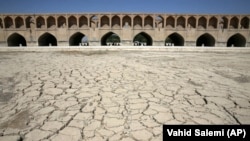The looming water crisis in Iran is “much more severe” than what has already been predicted, the head of Islamic Republic’s Department of Environment (DoE) and deputy President, Isa Kalantari has said, warning, “There will be no water in Iran within less than fifty years”.
The Islamic Republic authorities have repeatedly warned over the shortage of water, in recent years. In fact, water can run out sooner than Iran's oil reserves.
Isa Kalantari had earlier warned that more than 70% of Iran’s population is facing water shortage and the volume of consumption per person has passed the “critical” point.
DoE’s head has made his comments in an interview with the state-run Iran Labor News Agency (ILNA), in response to alarming remarks of a prominent university professor, Parviz Kardovani, renowned as father of Iran’s “Geology”.
Director of Iran’s Desert Studies Center, Professor Kardovani has been warning over water crisis in the country for more than a decade.
“Large swathes of Iran will be on track for severe water shortage in fifty years,” Kardovani cautioned about a decade ago, adding, “Because of excessive water consumption, the Central Plateau of Iran will be facing water crisis within half a century.”
According to Kardavani, human activities, lifestyle, poor management of resources and urban development are the main causes of the looming crisis.
Meanwhile, Kardavani has repeatedly blamed what he describes as excessive “construction of dams in wrong spots”, for aggravating water crisis in Iran.
“Miserable will be the ones born fifty years from now; then there will be no surface or underground water resources left in the country,” Kardavani has speculated, noting that the disaster might occur even sooner than that.
As there is no plan for rationing water in the country, Kardavani has predicted that all the wells and dam reservoirs will dry up in half a century, or less.
Citing these ominous predictions, DoE’s head, Kalantari has described Kardavani’s remarks as “over optimistic”, noting, “Iran will be left with no water much sooner than fifty years.”
Lambasting proponents of population growth in Iran, Kalantari had earlier said, “Stop repeating the shibboleth and saying our country is great. Our resources are limited.”
The Islamic Republic’s Supreme Leader Ayatollah Ali Khamenei is the main proponent of population growth. In 2014, he issued an edict for reducing the legal age for marriage and encouraging families to have more children.
Kalantari had previously echoed other experts’ warnings, asserting, “Iran’s 8,000-year-old civilization will be destroyed if the level of our water consumption is not reduced.”
He further warned that if Iran does not change its approach to water use, the result would be mass migration.
“If water consumption for agriculture remains at this level, in less than 25 years Iran’s eastern and southern areas will be completely deserted, and 50 million people will have to emigrate,” he added.
Widespread protests have broken out in Iran since the beginning of the Iranian new year (March 21) over water, a growing political concern due to a drought which residents of parched areas and analysts say has been exacerbated by mismanagement.
On February 14, hundreds of enraged farmers from eastern parts of Isfahan stormed the Friday Prayer location in the provincial capital, among them many women, to protest water mismanagement.
Chanting, “America is not our enemy, our enemy is right here”, the farmers called for a fair distribution of water.
Months later, city of Kazeroon, southern Iran, experienced a similar incident concerning a dispute over a plan for dividing the city and re-distributing its water resources.
Oil-rich Khuzestan Province in southwestern Iran and Borazjan in the south have also witnessed protest rallies over the shortage of water in recent months.
All these protests have occasionally turned into bloody clashes between the demonstrators and security forces.
According to the Minister of Interior, Abdor-Reza Rahmani Fazli, there had been at least twenty cases of protest rallies held over the shortage of water in past five months across Iran.
However, the Islamic Republic’s Supreme Leader Ayatollah Ali Khamenei believes that all these uprisings are provoked by “foreign enemies”, i.e. Israel, Saudi Arabia and US.





